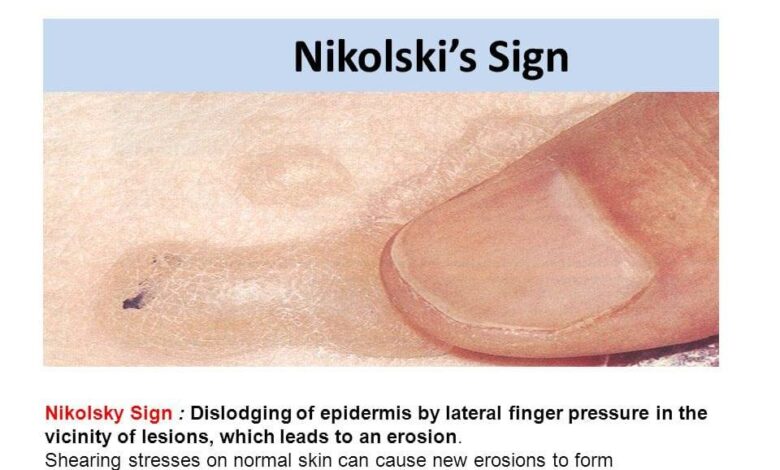Symptom Nikolsky: What's it, causes, symptoms, diagnostics, treatment, prevention

Nikolsky sign
What is Nikolsky's symptom?
Symptom Nikolsky, also known as “symptom of irritation” or “positive Nikolsky sign”, is a medical term, describing the reaction of the skin to mechanical stress. With gentle or light rubbing of the skin, redness and peeling of the upper layer of the skin appear. This symptom can be an indicator of various diseases and conditions., including dermatological and infectious diseases.
The disease is more common in newborns and young children up to 5 years. It often appears in the mouth and on the neck., shoulder, armpit and genital area. The child may be lethargic, irritable, feverish. Painful red blisters may form on the skin, which break easily.
This sign may be in adults with impaired kidney function or with a weak immune system.. Your doctor may use a pencil eraser or finger to check for Nikolsky's sign. The skin is pulled to the side by shearing pressure on its surface or by rotating the eraser back and forth..
If the test result is positive, very thin top layer of skin will peel off.
A positive result is usually a sign of blisters on the skin. People with a positive sign have loose skin, which is separated from the underlying layers by friction.
Causes of Nikolsky's symptom
Nikolsky's symptom is usually associated with a violation of the structure of the epithelium, top layer of skin. This can be caused by various reasons:
- Dermatological diseases: Some skin diseases, such as psoriasis, eczema and dermatitis, may be accompanied by changes in the structure of the skin, which makes her more prone to irritation.
- Infection: Infectious diseases, such as bacterial or viral infections, can cause inflammation of the skin and increase sensitivity to mechanical stress.
- Allergic reactions: Allergic reactions to certain substances can lead to changes in the structure of the skin and cause Nikolsky's sign..
- Stress and health changes: Some physical and emotional stresses can affect the quality of the skin and cause it to become more sensitive..
Manifestations of Nikolsky's symptom
The main symptom of Nikolsky's Symptom is the appearance of redness and peeling of the upper layer of the skin after a slight mechanical impact.. Other possible symptoms may include:
- Weak redness: The skin may become slightly reddened at the site of friction or even with light pressure..
- Flaking skin: After rubbing, small flaking areas may appear on the skin.
- Discomfort and itching: Some people may experience discomfort, itching or burning at the site of the symptom.
When to see a doctor
If you notice the appearance of Nikolsky's symptom on your skin, especially if it is accompanied by other symptoms, such as severe itching, inflammation or rashes, it is important to see a doctor. Nikolsky's symptom can be a sign of various diseases, and only a professional assessment can determine its cause.
Questions, which the doctor may ask
The doctor may ask the following questions, to better understand the nature of the Nikolsky symptom and its relationship to your health:
- When did you first notice the onset of the symptom?
- Do you have a history of allergic reactions or skin conditions?
- Is there anything, which exacerbates Nikolsky's symptom?
- You experience discomfort, itching or other symptoms at the site of the symptom?
Diagnosis of Nikolsky's symptom
Diagnosis of Nikolsky's symptom includes an analysis of symptoms, medical history and additional research. The doctor may also consider ruling out other possible causes., such as allergies, infections or dermatological conditions.
Treatment of Nikolsky's Symptom
Treatment of Nikolsky's symptom depends on its cause.. The doctor may prescribe the following approaches:
- Treatment of the underlying disease: If Nikolsky's symptom is caused by any underlying disease, eg, allergies or dermatitis, treatment will focus on managing these conditions.
- Anti-inflammatory agents: Your doctor may prescribe anti-inflammatory ointments or creams to reduce skin inflammation..
- Antihistamines: In the event of an allergic reaction, antihistamines may be prescribed to relieve allergy symptoms..
Home Treatment
In addition to professional help, you can take the following steps at home to reduce Nikolsky symptom:
- Avoid mechanical irritation: Try to avoid unnecessary rubbing or pressure on the skin, to prevent symptoms.
- Use gentle hygiene products: When choosing hygiene products, such as soap or shower gel, prefer you, which do not contain aggressive chemical components.
Prevention of Nikolsky's symptom
To prevent Nikolsky's symptom, it is recommended to follow some recommendations:
- Avoid contact with irritants: If you have known allergies or sensitivities to certain substances, try to avoid contact with them.
- Keep your skin hydrated: Hydrated skin is less prone to irritation, so use skin moisturizers.
It is important to remember, that Nikolsky's symptom may be an indicator of more serious diseases, therefore, in case of any doubt or worsening of symptoms, medical attention should be sought.
Used sources and literature
Fitzpatrick IS, High WA, Kyle WL. Blisters and vesicles. In: Fitzpatrick IS, High WA, Kyle WL, eds. Urgent Care Dermatology: Symptom-Based Diagnosis. Philadelphia, PA: Elsevier; 2018:chap 11.
Grayson W, Calonje E. Infectious diseases of the skin. In: Calonje E, Brenn T, Lazar AJ, Billings SD, eds. McKee’s Pathology of the skin. 5th ed. Philadelphia, PA: Elsevier; 2020:chap 18.
Levin LE, Garzon MC, Lauren CT, Morel KD. Dermatology. In: Polin RA, Ditmar MF, eds. Pediatric Secrets. 7th ed. Philadelphia, PA: Elsevier; 2021:chap 4.
CA frame. Dermatologic presentations. In: Walls RM, Hockberger RS, Gausche-Hill M, eds. Rosen’s Emergency Medicine: Concepts and Clinical Practice. 9th ed. Philadelphia, PA: Elsevier; 2018:chap 110.
